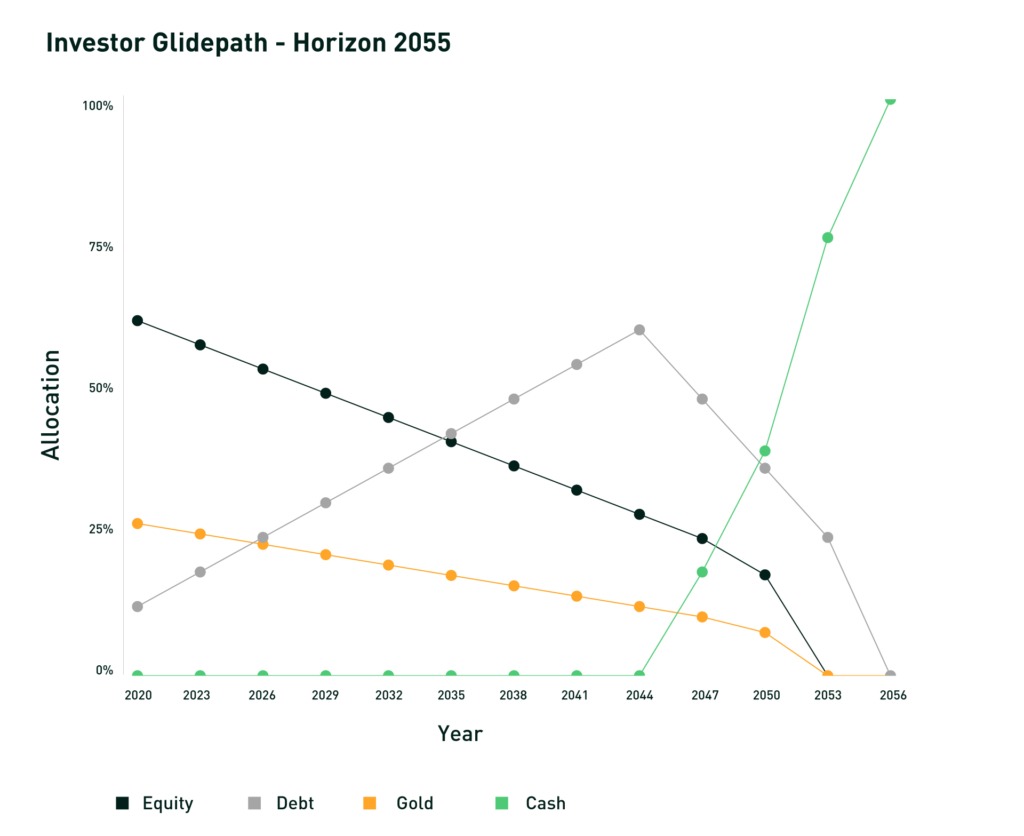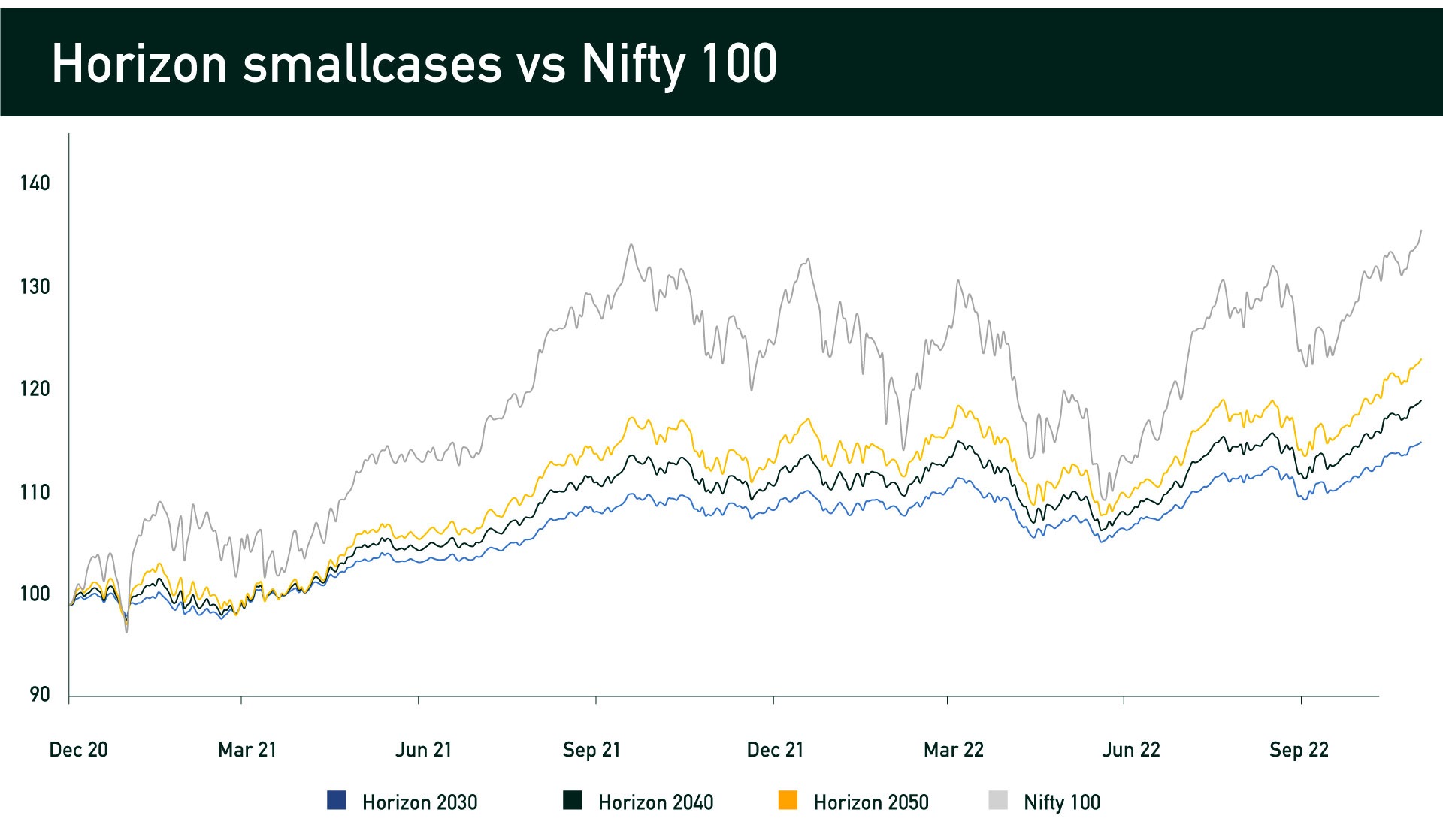All About Horizon smallcases

In this edition of smallcase in focus, we will talk to you about one of the most unique set of smallcases that we launched almost a year ago – Horizon smallcases. The reason to do this is to enforce the ethos with which the idea was conceived as well as update you on the performance of these smallcases.
The core motivation behind Horizon smallcases was to do away with the conventional form of goal-based investing. Or very popularly known as retirement investing. You may ask, why? As mentioned in our previous blog post, you see most of the current goal-based investment options work backwards and give a monthly/quarterly investment amount that the user needs to invest, in order to achieve the final terminal value. This approach doesn’t take into consideration the actual investment capacity or fluctuating investable cash in the hands of the investors.
We thought, why not do it the other way round? You see the problem with the approach mentioned above is it’s restrictive. Our reckoning is that the best way to do this is by letting the investor decide both the frequency and amount of investment she is willing to make for the particular goal. The second important bit is that ideally the portfolio should have a dynamic allocation. Dynamic allocation ensures that during the closing stages of your investment period, money is taken off from riskier assets and diverted to less riskier assets in order to abate any crisis.
Keeping the aforementioned in mind, the way Horizon smallcases function is by investing in different asset classes – equity, debt, gold, cash. During the initial years of your investments, a higher proportion of investments are directed towards equity and gold for wealth maximization and during the later stages more on debt and cash for wealth protection.
From a technical standpoint, this process is known as glide-path investing. Each Horizon smallcase follows a particular glide path, which begins with greater equity & gold allocations, and slowly moves the allocation towards more conservative instruments. A glide path can be thought of as an investment layout or weighing scheme that an investor witnesses over the course of their goal-based investment journey. It is a mapping of the weightage of the asset allocation scheme based on the target date.
At the beginning of the goal-based investment journey, when the target year is far and the investor has substantial risk-taking ability, greater weight is allocated to equity & gold assets to capture growth – but this comes with increased volatility. Gradually the portfolio is rebalanced to accommodate a greater percentage of fixed income than equity & gold as the investor turns midway in their investment journey and their risk appetite also decreases. Eventually, everything is moved to cash equivalents at the target date as the investor has retired and no longer has the ability to take any risk at this point. Ergo, aligning this mix of equity, gold, fixed income & cash equivalents along the journey with the investor’s risk appetite and mapping out the different mix of various assets at the end of each year is what is called a glide path.
The chart below shows the exact allocation mapping for Horizon 2055 smallcase.

Now, let’s use this as a segue to talk about the performance distinction amongst Horizon smallcases with different maturities. For this purpose, we’ll be using Horizon 2030, 2040, and 2050. Needless to mention, as the name suggests, if you wish to achieve a goal by 2030, you pick the first smallcase and if the target year is 2050, you pick the last smallcase.


You see a very clear trend, right? As you stretch the maturity, the smallcase returns keep getting better. The reason is simply what we spoke about earlier, which is glide-path investing. Take a look at the current allocation between these 3 smallcases.

What do we understand from this? The first thing to note is that the equity allocation in the 2030 portfolio is almost half of that in 2050. Second thing, you must have noticed that the 2040 and 2050 portfolios don’t have a cash component currently, while the 2030 one does. If you scroll up and refer to the glidepath graph, you’ll see that the cash component (green line) only gets introduced in the year 2045, which is 10 years before maturity. It is pertinent to understand this in the context of what has transpired in the equity markets over the last couple of years. Since equity as an asset class has broadly outperformed, we are witnessing better performance on the farther maturity smallcases. However, the case would have been different if equities had underperformed. Then, Horizon 2030 would have had better returns than Horizon 2050. This actually gives us the leeway to play aggressively on the farther maturities portfolios, as the prospects for equities continue to remain strong.
To conclude, we would like to urge our investors to view Horizon with the right lens. Getting influenced by the 1-year or 2-year performance would be counter-productive for anyone who wishes to make their goals realize by investing into Horizon. You have to identify your goal post clearly and be disciplined to stick to it. In simpler words, you’ve to be in it for the long haul!



